
|
Benedictines, Cistercians,
Trappists, and Carthusians |
|||||
Stanley Roseman
The MONASTIC LIFE
The MONASTIC LIFE
The FOUR MONASTIC ORDERS of the WESTERN CHURCH
The Carthusians
© Stanley Roseman and Ronald Davis - All Rights Reserved
Visual imagery and website content may not be reproduced in any form whatsoever.
Visual imagery and website content may not be reproduced in any form whatsoever.
At Vigils, from 12:30 to 3:00 a.m., Roseman drew the hermit monks while they chanted the Psalms and read from the Scriptures, stood, bowed, knelt, and prayed in the night.
7. St. Hugh's Charterhouse, Parkminster, with the Church Spire rising above the Hermitages.
England, Winter of 1983.
England, Winter of 1983.
12. Portrait of a Carthusian Monk
in Prayer, 1984
St. Hugh's Charterhouse
Parkminster, England
Chalks on paper, 50 x 35 cm
Teylers Museum, The Netherlands
in Prayer, 1984
St. Hugh's Charterhouse
Parkminster, England
Chalks on paper, 50 x 35 cm
Teylers Museum, The Netherlands
The Artist and the Carthusians
Portrait of a Carthusian Monk in Prayer and an equally fine portrait of Brother Augustine, also from the Order's ninth centenary year, are conserved in the Teyler Museum, the Netherlands. The museum houses a renowned collection of Italian Renaissance master drawings, including works by Michelangelo and Raphael, and the Seventeenth-Century Dutch School, notably drawings by Rembrandt.
The portrait drawings of the Carthusian monk from Parkminster joined earlier acquisitions from Roseman's work on the monastic life and with other subjects from his extensive corpus of drawings. In letter of November 1989 to Davis, the Curator Carel van Tuyll praises "the splendid portraits of monks" and concludes, ". . . it is a cause of profound gratitude on our part to be able to show such an excellent group of Mr. Roseman's drawings.''
- Carel van Tuyll, Chief Curator
Teylers Museum, The Netherlands
Teylers Museum, The Netherlands
5. A Carthusian Monk
at Vigils, 1982
La Chartreuse de la Valsainte,
Switzerland
Chalks on paper, 50 x 35 cm
Musée Ingres, Montauban
at Vigils, 1982
La Chartreuse de la Valsainte,
Switzerland
Chalks on paper, 50 x 35 cm
Musée Ingres, Montauban
In this deeply felt drawing of the Carthusian monk at Vigils, Roseman's subtle gradation of the single bistre chalk ranges from fine rendering of the hermit's face and beard to bold strokes that define shadows from the fall of light on the Carthusian monk's hood, down his shoulder and arm, and under the sleeve of his habit. With an economy of line, Roseman has created a drawing of spiritual intensity in the depiction of the hermit monk in prayer in the night.
Acquiring A Carthusian Monk at Vigils for the Musée Ingres in 1986, the distinguished curator Pierre Barousse praises the "very beautiful drawing" in letter of appreciation to Stanley Roseman and further writes:
"I am, for what is meaningful to me, very sensitive to the purity
and the profound interiority expressed in this work of art.''
and the profound interiority expressed in this work of art.''
- Pierre Barousse, Curator
Musée Ingres, Montauban
Musée Ingres, Montauban
6. A Carthusian Monk Asleep in his Cell, 1982, La Chartreuse de la Valsainte,
Switzerland
Chalks on paper, 35 x 50 cm
Ashmolean Museum, Oxford
Switzerland
Chalks on paper, 35 x 50 cm
Ashmolean Museum, Oxford
"that fine drawing of the Carthusian monk asleep in his cell by Stanley Roseman"
- Kenneth Garlick, Keeper of Western Art
Ashmolean Museum, Oxford
Ashmolean Museum, Oxford
St. Hugh's Charterhouse, known as Parkminster, located in the countryside of West Sussex, is the only Carthusian monastery in the British Isles today. Writing about the Carthusians, Roseman relates: "The history of the Carthusian Order in England goes back to c.1178-79 when King Henry II founded the first Carthusian monastery, at Witham in Somerset. . . .[7] Under Henry VIII's reign (1509-47), the eleven Carthusian monasteries in the British Isles, with other religious houses, were suppressed. The Acts of Catholic Emancipation, from the late eighteenth to early nineteenth century, brought a revival of monastic life in Great Britain. Parkminster dates from the last quarter of the nineteenth century."
2. La Chartreuse de la Valsainte, with the Hermitages of the Carthusian Monks.
Switzerland, winter 1982
Switzerland, winter 1982
3. Stanley Roseman drawing a Carthusian Monk in Prostration
on the Steps to the High Altar,
La Chartreuse de la Valsainte, Switzerland, 1982
on the Steps to the High Altar,
La Chartreuse de la Valsainte, Switzerland, 1982
"Living in hermitages and observing the principles of obedience, humility, and silence that are prescribed in the Rule of St. Benedict, the Carthusians follow an eremitic ideal inspired by the Desert Fathers.
"In the desert along the Middle Nile in about the year 285, St. Antony withdrew to an isolated locality at Pispir, later referred to as his 'outer mountain.' At the Western Egyptian Desert, c.330, the saintly ascetic Amoun built cells on a promontory called the Mountain of Nitria.[3]
4. A Carthusian Monk in Prostration, 1982
La Chartreuse de la Valsainte, Switzerland
Chalks on paper, 35 x 50 cm
Private collection, Switzerland
La Chartreuse de la Valsainte, Switzerland
Chalks on paper, 35 x 50 cm
Private collection, Switzerland
The Chartreuse de la Valsainte is the only Carthusian monastery in Switzerland. The cordial letter of invitation from the Prior Dom Augustin Tönz in winter 1982 gave Stanley Roseman the important opportunity to include Carthusian monks in his work. Dom Augustin writes to the artist and his colleague Ronald Davis: "We thank you heartily for your interest in monastic life. . . .'' The Prior warmly closes his letter: "Looking forward to receiving you here . . . . We pray with you for the Lord's choice blessings for yourselves and your work.''
"The 'mountain in the desert' offered those pioneers of eremitic, Christian monasticism a solitary place to seek their personal union with God. For generations thereafter throughout Europe, contemplative men and women found their own spiritual deserts in remote mountain sites."
In his research on monasticism, Roseman came upon a reference to the Chartreuse de la Valsainte, founded in 1295 in the Gruyères range of the Swiss Alps. The artist recounts: "That La Valsainte is a relatively unknown Carthusian monastery, even within the monastic world, and has an eventful history that includes political suppression, appropriation of the monastery from 1791-98 by monks from the Abbey of La Trappe, with which I have a close association, and the reestablishment in the mid-nineteenth century of La Valsainte as a Carthusian monastery interested me greatly. The allure of the Monastery's remote location in the Swiss Alps increased my interest - more so living in Switzerland - to include La Valsainte in my work."
''The pictures - splendid and telling all at once - form the stimulating vanguard
towards so original and deep a study of the monastic life.''
towards so original and deep a study of the monastic life.''
The respected art journal ARA arte religioso actual, Madrid, published in the fall of 1979 an enthusiastic reportage entitled ''Stanley Roseman y la Vida Monastica'' and states:
- ARA arte religioso actual, Madrid
The eremitical movement in eleventh-century Europe was in response to an ardent quest for a life of solitude and prayer. The Hermitage and Monastery of Camaldoli, founded in the Apennines by St. Romuald of Ravenna in 1023-24, encouraged numerous adherents to the growing eremitical movement. St. Robert of Molesme lived with hermits in the Burgundian Forest of Collan in 1074 and some fifteen years later founded the Monastery of Cîteaux, the birthplace of the Cistercian Order. St. Bruno of Cologne, Chancellor of Rheims Cathedral, is revered as the founder of the Carthusian Order, which dates from 1084.[1]
The Carthusian Order provides for the solitary life of the hermit within the context of a monastic community. The austerity and solitude of Carthusian monasticism account for the relatively small number of monasteries, today numbering twenty-three in the Order.
Carthusian monks, as at La Valsainte, gather in choir for conventual Mass in the mornings, Vespers in the late afternoons, and Vigils in the night. The Carthusians combine the Office of Lauds with Vigils for the two-and-a-half to three-hour Night Office that begins after midnight. The daytime Offices of Prime, Terce, Sext, None, and Compline are observed by the monk in his cell. Roseman writes:
Friendship with Brother Louis
Roseman and Davis were warmly welcomed at La Valsainte. The Prior Dom Augustin and the retired Prior Dom Nicolas Barras were greatly encouraging to the artist in his work on the monastic life, as were members of the community whom the artist came to know. In appreciation Roseman writes:
St. Hugh's Charterhouse, Parkminster
Portrait of a Carthusian Monk in Prayer, 1984
St Hugh's Charterhouse, Parkminster, England
Chalks on paper, 50 x 35 cm
Teylers Museum, The Netherlands
St Hugh's Charterhouse, Parkminster, England
Chalks on paper, 50 x 35 cm
Teylers Museum, The Netherlands
"Over the days that followed our arrival, the long vaulted cloister, the hermitages, and the church became familiar to me, and the work I created with the encouragement of the hermit monks brought renewed invitations and subsequent returns to the Chartreuse de la Valsainte.''
Brother Louis, the Carthusian monk in the Musée Ingres drawing above, was the memorable subject of a number of Roseman's drawings at La Valsainte. The Prior Dom Augustin had thoughtfully introduced Roseman to Brother Louis revered by the community as a holy man. The Prior gave the artist permission to be with the hermit monk and to draw him in his cell, where he read, wrote, took his meals, studied, meditated and prayed. An equally beautiful drawing of the hermit monk kneeling in prayer in his cell was included in the gift of Roseman's work that he and Davis presented to the monastery.
"The friendship that grew from the days I visited Brother Louis in his cell," writes Roseman, "was an enriching experience for my art and my life. His correspondence with Ronald and me over the years has meant very much as when Brother Louis writes in December 1985: 'God bless you and help you to fulfill well your lifework' and 'I keep you always included in my prayers.' ''
"How glad I am to be enabled through your drawing to make known God in the world, not by preaching but even by sleeping. . . . May my picture of the sleeping monk show somehow Jesus born in the crib or extinguished on the cross, for He is always love and peace."
"And doing this I enter into a state of indescribable peace and deep joy, rather heavenly than earthly. Maybe your drawing you have made is somewhat translucent of this state and therefore is so pleasing to many people. . . . I think that a big part of success in your art is due to the simplicity of your heart, which is able to see right and to guide your hand to reproduce what your eye has seen. . . . I felicitate you for your talent and thank God with you. And I send to both of you, Stanley and Ronald my loving greetings in Christ, our Lord,
The Ashmolean Museum, Oxford University, which houses a renowned collection of master drawings, acquired the beautiful drawing of Brother Louis taking a siesta, (fig. 6, below). A Carthusian Monk Asleep in his Cell, further exemplifies the Roseman's consummate draughtsmanship. Brother Louis, having received a letter from the artist telling him of the Ashmolean Museum's acquisition, writes, in English, in letter of January 1983:
In the photograph above, the artist is seated on his haunches as he draws the Carthusian monk in prostration before the high altar. The artist's drawing board with sheets of paper rests on a knee, his box of chalks by his feet. Tucked into his work apron is a cloth for wiping the chalk dust off his hands.
Brother Louis writes in March 1989 of "that picture made so well of your masterly hand of artist" and adds, "I have always with me the reality of it - myself reposing peacefully in God. . . .
The Encyclopaedia of Oxford, edited by Oxford historian Christopher Hibbert, notes that the Ashmolean Museum acquired the work of Stanley Roseman.[6]
The hermitages of a Carthusian monastery, such as those at Parkminster, are two-storied, stone dwellings, each with a small garden enclosed by a high wall. The upper story contains the monk's cell; the ground level, a workroom. The hermitages are connected by corridors to the cloister that leads to the church.
The Prior of Parkminster, Dom Bernard O'Donovan, wrote in January of 1983 a cordial letter of invitation to Roseman and Davis. Addressing his letter to Davis, who had written to introduce Roseman's work on the monastic life and to explain their request for a visit, the Prior Dom Bernard writes: "I congratulate your friend and yourself on this good work.''
Dom Bernard, a tall, bespectacled, pleasant Irishman who had been a physician in Dublin before entering St. Hugh's Charterhouse, warmly received Roseman and Davis the following month. The Prior expressed his admiration for the works of art that Roseman was creating on the monastic life and assured his two guests of his personal support and encouragement.
Relating some history of Parkminster, Dom Bernard told them that the monastery was established in 1873, when three monks were given the present property, then called Parknowle. The monastic buildings were constructed from 1876, and the church was consecrated in 1883. The Prior remarked that the monastery was presently celebrating the one-hundredth anniversary of the consecration of the church and Roseman's work at Parkminister would be especially significant.
8. The Hermitages and Cloister of Parkminster, winter 1983.
The Prior invited Roseman to draw the hermit monks at Vigils. Each night, shortly before half-past twelve, the Prior came up to the artist's room to bring him to the Night Office. With a flashlight Dom Bernard led Roseman down the darkened stairwell and through the long, dark cloister, "like a freezing, vaulted tunnel through the monastery," writes the artist.
"Escorting me into the church as the hermit monks were entering from the sacristy, the Prior brought me into the choir stalls to sit with the community. . . .
The artist further relates drawing at the Night Office:
The 900th Anniversary of the Founding of the Carthusian Order
The Prior Dom Bernard thoughtfully invited Roseman and Davis to return to St. Hugh's Charterhouse in 1984, the year marking the 900th anniversary of the founding of the Carthusian Order. Davis wrote to Dom Bernard in regards to dates for returning to Parkminster. The Prior warmly replied: "I shall be pleased to have you here for the dates you mentioned. . . . I look forward to meeting you both again. . . . God bless. Fr. Bernard"
Roseman's interest in monastic life, his studies on the subject, and the encouragement of monks and nuns led him to write a text to accompany his work in the monasteries.[2] The artist writes about the ancient tradition of eremitic monasticism and the Carthusian Order.
"During our sojourn that February at Parkminster," Roseman recounts, "The winter was severely cold, and the water main to the Monastery had frozen and burst. The Prior thoughtfully provided Ronald and me with extra blankets and a portable kerosene burner for each of our rooms. Ronald and I carried water up from a well in a shed in a courtyard by the kitchen and heated water in kettles for washing and shaving. . . .
Brother Augustine, an amiable, bearded Dutchman, is the subject of the impressive portrait drawing in chalks on gray paper of the hooded hermit monk in prayer, presented at the top of the page and here, (fig. 12). Roseman recalls, "I drew Brother Augustine in choir, and I also drew him in his hermitage, where he kindly invited me for a walk in the beautiful, trellised garden he had designed, built, and cultivated - a meditative outdoor space within the confines of his hermitage.''
"The hermit monks took large, leather-bound Psalters from shelves of the choir stalls, placed the books on top of the railings in front of them, and opened the Psalters from which to chant the Night Office. The Prior tapped his ring on the side of his choir stall, and the monks stood for silent prayer. At a second tap of the Prior's ring the cantor led the invocation from Psalm 51: 'Lord, open my lips;' the monks responded in unison, 'And my mouth will proclaim your praise.' "
Portraiture
"Our meals were brought to us in portable wooden containers called, from the French, portoirs, similar to those containers for carrying meals to the monks in their hermitages. Each portoir is placed in a hatch next to a monk's hermitage door. . . . The kindly, eighty-year old, white-bearded cook Brother Christopher, whom I drew in the kitchen, prepared delicious dinners of fish, the staple diet of the Carthusians. Although Carthusians have only one meal a day, at midday, Brother Christopher thoughtfully prepared for Ronald and me soup and tasty omelettes for our suppers, with homemade oatmeal cookies for desserts. . . .''
In letter of acquisition, September 1982, from Dr. Kenneth Garlick, Keeper of Western Art, Ashmolean Museum, to Ronald Davis, who introduced his colleague's work to the Museum, the eminent curator writes in praise of:
your Brother Louis"
1. Louis J. Lekai, The Cistercians, (Ohio: Kent State University Press, 1977), p. 11.
2. The Oxford scholar and Benedictine monk Dom Bernard Green read a draft of Roseman's manuscript and wrote in a gracious letter
to the artist: "You portray the background and the aims of life in monasteries so well, showing such a deep understanding of the monastic life.''
3. The Lives of the Desert Fathers, translated by Norman Russell, (Oxford: Mowbray, and Michigan: Cistercian Studies, 1980), pp. 111, 112, 134.
4. The Psalter is comprised of one hundred and fifty Psalms. Psalms 10 to 148 in the Hebrew Bible are one number ahead of the Greek
Septuagint and Latin Vulgate Bibles. The Greek and the Vulgate combine Psalms 9 and 10 as well as Psalms 114 and 115
while separating into two parts each Psalm 116 and Psalm 148.
5. The Rule of St. Benedict uses the numbering of the Psalms in the Vulgate Bible.
6. The Encyclopaedia of Oxford, edited by Christopher Hibbert, (London: Macmillan, 1988), p. 40.
7. David Knowles, The Monastic Order in England, (Cambridge, Cambridge University Press, 1976), p. 381.
2. The Oxford scholar and Benedictine monk Dom Bernard Green read a draft of Roseman's manuscript and wrote in a gracious letter
to the artist: "You portray the background and the aims of life in monasteries so well, showing such a deep understanding of the monastic life.''
3. The Lives of the Desert Fathers, translated by Norman Russell, (Oxford: Mowbray, and Michigan: Cistercian Studies, 1980), pp. 111, 112, 134.
4. The Psalter is comprised of one hundred and fifty Psalms. Psalms 10 to 148 in the Hebrew Bible are one number ahead of the Greek
Septuagint and Latin Vulgate Bibles. The Greek and the Vulgate combine Psalms 9 and 10 as well as Psalms 114 and 115
while separating into two parts each Psalm 116 and Psalm 148.
5. The Rule of St. Benedict uses the numbering of the Psalms in the Vulgate Bible.
6. The Encyclopaedia of Oxford, edited by Christopher Hibbert, (London: Macmillan, 1988), p. 40.
7. David Knowles, The Monastic Order in England, (Cambridge, Cambridge University Press, 1976), p. 381.
A Carthusian Monk Tolling the Church Bell and A Carthusian Monk Kneeling in Prayer at Vigils were gifts to St Hugh's Charterhouse from Roseman and Davis in appreciation to the Prior Dom Bernard and the monks for their gracious hospitality and encouragement of the artist's work on the monastic life. As seen here, the drawings express complementary images of a Carthusian monk's dedication to the contemplative life.
Portraiture holds an important place in Roseman's oeuvre. In a Sunday magazine cover story, 1979, on the artist, the leading Swedish daily Aftonbladet, Stockholm, commends Roseman for creating portraits "artistically on a high level as well as accurately expressive of the human dimension.''
At Parkminster, Roseman's portraits include the Prior Dom Bernard; the retired Prior Dom Guy, a former London lawyer and who was equally enthusiastic about Roseman's work; Brother Paul, the stocky, bearded carpenter; Dom Emmanuel, an elderly French monk and former cavalry officer in the French Army; and the Polish cook Brother Christopher, whom the artist fondly remembers having prepared delicious fish dinners, omelettes for suppers, and homemade oatmeal cookies for desserts.
With black and bistre chalks on beige paper, Roseman drew the present work depicting a monk in prostration in the church of La Valsainte, (fig. 4). The Carthusians wear habits of undyed wool, the color of which the artist has suggested in his use of beige paper.
Roseman's drawings from the Chartreuse de la Valsainte expanded the scope of the artist's oeuvre created in monasteries throughout Europe to include the four monastic orders of the Western Church.
The striking composition places the figure high on the page which, in contrast, lowers the perspective from which the figure is viewed in the drawing and emphasizes the extent of floor. The monk's humility and devotion to God are vividly expressed in this impressive drawing entitled A Carthusian Monk in Prostration.
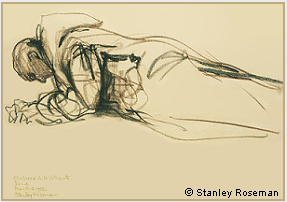
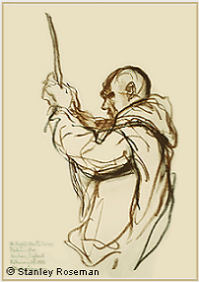
9. A Carthusian Monk
Kneeling in Prayer at Vigils
1983, St. Hugh's Charterhouse,
Parkminster, England
Chalks on paper, 50 x 35 cm
Collection St. Hugh's Charterhouse
Kneeling in Prayer at Vigils
1983, St. Hugh's Charterhouse,
Parkminster, England
Chalks on paper, 50 x 35 cm
Collection St. Hugh's Charterhouse
A Carthusian Monk Kneeling in Prayer at Vigils, (fig. 9), depicts the hermit, in his voluminous woolen habit, turned towards the altar and kneeling in prayer. The pyramidal composition in the drawing is reaffirmed in the leitmotif of the triangular shape of the monk's hood and the folds of his habit. The triangle is a compositional element with Christian meaning as the triangle is a symbol of the Trinity. Here Roseman creates an impressive image of a monk kneeling in prayer.
"At the conclusion of Vigils, one of the monks took hold of the bell tower rope and sounded the church bell three times for the Angelus. The monks stood in silence. With a second sounding of the bell three times, the monks knelt. When the bell ringer sounded the bell three more times, the monks prostrated themselves in the aisles of the choir stalls. After some minutes, the Prior tapped his ring and the hermit monks stood, bowed towards the altar, closed and replaced their Psalters, and filed silently out of the church.''
Presented here is the fine drawing entitled A Carthusian Monk Tolling the Church Bell, (fig. 10). Roseman draws with strong, fluent strokes of black and bistre chalks to give movement to the figure and to express the concentrated action of the monk tolling the bell to announce the Angelus.

See letters from Brother Louis on the page "Correspondence from the Monasteries."
10. A Carthusian Monk
Tolling the Church Bell
1983, St. Hugh's Charterhouse,
Parkminster, England
Chalks on paper, 50 x 35 cm
Collection St. Hugh's Charterhouse
Tolling the Church Bell
1983, St. Hugh's Charterhouse,
Parkminster, England
Chalks on paper, 50 x 35 cm
Collection St. Hugh's Charterhouse
Page 5 - Carthusians
On the bottom of this page are links
to the other pages on the Monastic Orders.
On the bottom of this page are links
to the other pages on the Monastic Orders.
A further selection of Roseman's drawings from Parkminster are presented on "Monastic Journey Continued" -
"Returning to England." Carthusian nuns at Certosa di Riva, Piedmont, are presented on "Monastic Journey Continued" -
"Convents in Piedmont and Tuscany."
"Returning to England." Carthusian nuns at Certosa di Riva, Piedmont, are presented on "Monastic Journey Continued" -
"Convents in Piedmont and Tuscany."
Page 5 - Carthusians
"The canonical hours, called the Divine Office, are founded on singing the Psalms. 'Lord open my lips, and my mouth will proclaim your praise,' from Psalm 51, begins Vigils, the first and longest Office, sung to keep watch in the night.[5]
''The Prophet states in the Book of Psalms, 'At midnight I rise to praise you, O Lord' and 'Seven times a day I praise you.' This call to prayer from Psalm 119, 'In praise of the Divine Law,' gives monastic life its definitive form and structure.[4]
A Carthusian Monk at Vigils, (fig. 5), is conserved in the Musée Ingres, Montauban. The renowned collection grew from a bequest by Ingres, whose well-quoted maxim asserts: "Drawing is the integrity of art."
Dom Bede, who was Assistant Procurator for thirty years, had befriended the artist and his colleague on their first sojourn at Parkminster. A kindly monk, Dom Bede thoughtfully brought Roseman and Davis to the library, where, as the artist recalls, "Dom Bede showed us wonderful rare books and manuscripts, including a 12th-century Gradual containing music for the Mass, and he kindly assisted us in our research and study on the Carthusian Order."
Roseman and Davis kept in touch with Dom Bede and were very appreciative when the hermit monk wrote in a thoughtful card:
"To Stanley and Ronald, Affectionate Easter Greetings
from all your friends at St. Hugh's. fr Bede"
from all your friends at St. Hugh's. fr Bede"
From Roseman's drawings at Parkminster on the Carthusian Order's ninth centenary year is Portrait of a Carthusian Monk, 1984, (fig. 11), a deeply felt portrait of a hermit monk.
Portrait of a Carthusian Monk was acquired in 1986 by the Mead Art Museum, Amherst, Massachusetts, the state in which the artist was born. The Amherst College Museum's collection is noted for works on paper by American artists. The portrait entered the collection with Roseman's drawing from the Benedictine Abbey of St. Stephan, Augsburg. "I am very pleased with the drawings,'' writes the Museum's Director Frank Trapp in acknowledging "this fine gift to the collection of Amherst College.''
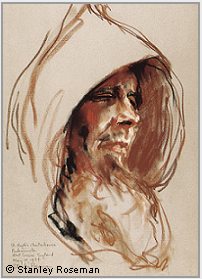
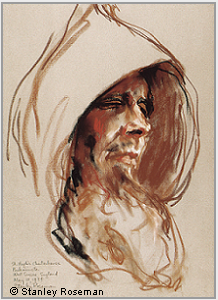
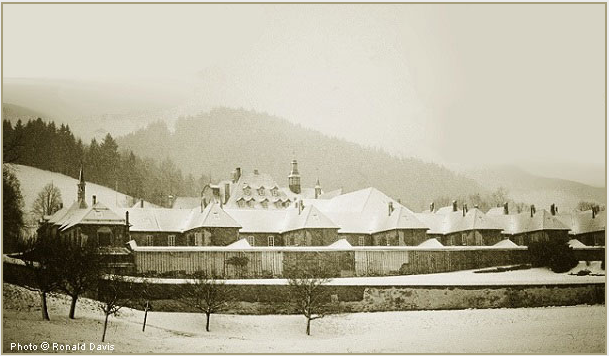
Hermit Monks in the Swiss Alps
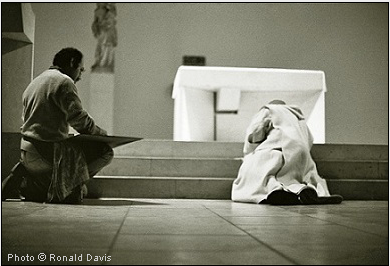
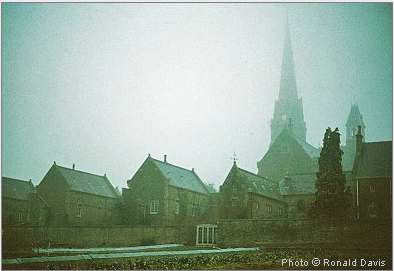
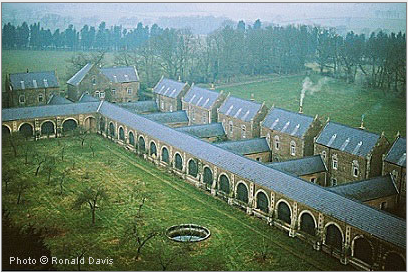
In the present work, Dom Bede is depicted in three-quarter profile with warm shading enhanced by white highlights on the face of the Carthusian monk. A few strokes of bistre chalk define the monk's hood lowered on his shoulders. With painterly, chiaroscuro modeling of the chalks complemented by fine linear description, Roseman created a superb portrait that conveys the asceticism and inner being of a man who had dedicated his many years to the contemplative life.
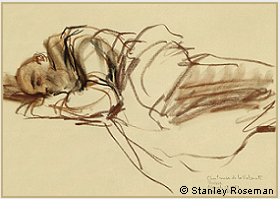
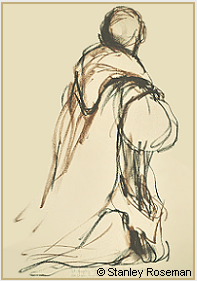
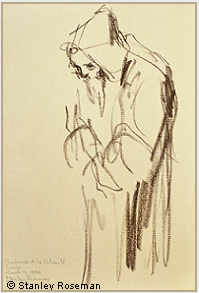
Vigils
"At midnight I rise to praise you, O Lord'' - Psalm 119:62
"O come, let us worship and bow down: let us kneel before the Lord our maker.''
- from Psalm 95, sung at Vigils
11. Portrait of a Carthusian Monk
1984, St. Hugh's Charterhouse
Parkminster, England
Chalks on paper, 50 x 35 cm
Mead Art Museum, Amherst College
Amherst, Massachusetts
1984, St. Hugh's Charterhouse
Parkminster, England
Chalks on paper, 50 x 35 cm
Mead Art Museum, Amherst College
Amherst, Massachusetts
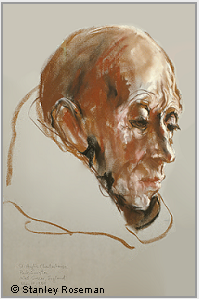
Davis' photographs of the monasteries complement
Roseman's drawings on the monastic life.
Roseman's drawings on the monastic life.